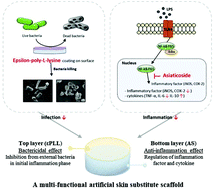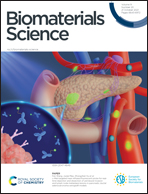A collagen-AS/εPLL bilayered artificial substitute regulates anti-inflammation and infection for initial inflamed wound healing†
Abstract
Despite the development of advanced tissue engineering substitutes, inflammation is still a significant problem that can arise from inflamed burn injuries, chronic wounds, or microbial diseases. Although topical wound dressing accelerates healing by minimizing or preventing the consequences of skin inflammation, there remains a need for the development of a novel substitute scaffold that can effectively eliminate immoderate inflammation and infection in the initial phase of the healing meachanism. In this study, an artificial skin substitute scaffold fabricated with asiaticoside (AS) and epsilon-poly-L-lysine (εPLL) was prepared. Upon the release of these bioactive compounds, they accelerate wound healing and inhibit any bacterial infection at the wound site. We determined whether AS and εPLL exhibit anti-inflammatory and bactericidal effects through different mechanisms. Collectively, the collagen-AS/εPLL artificial skin substitute could be a significant therapeutic agent for scar-less rapid wound healing (without infection and inflammation) of initially-inflamed full-thickness wounds.



 Please wait while we load your content...
Please wait while we load your content...